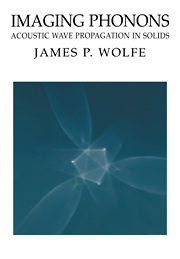Book contents
- Frontmatter
- Contents
- Preface
- Prologue – Anisotropic heat flow in crystals
- 1 Ballistic heat pulses and phonon imaging – A first look
- 2 Phonon focusing
- 3 Generation and detection of phonons – Experimental aspects
- 4 Focusing in cubic crystals
- 5 Acoustic symmetry and piezoelectricity
- 6 Lattice dynamics
- 7 Imaging of dispersive phonons
- 8 Phonon dynamics
- 9 Bulk scattering of phonons – Experiments
- 10 Quasidiffusion and the phonon source
- 11 Phonon scattering at interfaces
- 12 Refraction and reflection at solid/solid interfaces – Experiment
- 13 Imaging ultrasound in solids
- 14 Imaging surface acoustic waves
- 15 Interactions of ballistic phonons with electrons
- Appendix I Algebraic solution to the wave equation
- Appendix II Abbreviated tensor notation and group velocity
- Appendix III Survey of phonon focusing in cubic crystals
- Index
1 - Ballistic heat pulses and phonon imaging – A first look
Published online by Cambridge University Press: 24 March 2010
- Frontmatter
- Contents
- Preface
- Prologue – Anisotropic heat flow in crystals
- 1 Ballistic heat pulses and phonon imaging – A first look
- 2 Phonon focusing
- 3 Generation and detection of phonons – Experimental aspects
- 4 Focusing in cubic crystals
- 5 Acoustic symmetry and piezoelectricity
- 6 Lattice dynamics
- 7 Imaging of dispersive phonons
- 8 Phonon dynamics
- 9 Bulk scattering of phonons – Experiments
- 10 Quasidiffusion and the phonon source
- 11 Phonon scattering at interfaces
- 12 Refraction and reflection at solid/solid interfaces – Experiment
- 13 Imaging ultrasound in solids
- 14 Imaging surface acoustic waves
- 15 Interactions of ballistic phonons with electrons
- Appendix I Algebraic solution to the wave equation
- Appendix II Abbreviated tensor notation and group velocity
- Appendix III Survey of phonon focusing in cubic crystals
- Index
Summary
Time, space, and energy. These are the parameters of a heat-pulse experiment. The principal subject of investigation is nonequilibrium acoustic phonons in a crystalline solid. A phonon is the elementary quantum of vibrational energy of the atoms in the crystal. Historically, the thermal properties of solids have been measured by static or steady-state methods such as heat capacity and thermal conductivity. It is not surprising, then, that time- and spaceresolved measurements of nonequilibrium phonons have provided new perspectives on the thermal properties of condensed matter. The introduction of the heat-pulse method in 1964 by von Gutfeld and Nethercot has certainly revolutionized the way we view and understand phonons.
The basic method is quite simple: A nonmetallic crystal is cooled to a few degrees above absolute zero. A heat pulse is produced by passing a short burst of current through a metal strip deposited on the crystal or, alternatively, by optically exciting a metal film that has been deposited on one surface of the crystal. The electrically or optically excited film acts as a Planckian emitter of heat. Figure 1(a) schematically depicts the spatial distribution of heat energy (high-frequency acoustic phonons) at some instant of time after the excitation pulse. Several nonspherical “shells” of thermal energy, corresponding to longitudinal and transverse modes, propagate away from the heat source. The rise in temperature on the opposite face of the crystal is monitored with a superconducting metal film detector, labeled D.
- Type
- Chapter
- Information
- Imaging PhononsAcoustic Wave Propagation in Solids, pp. 10 - 20Publisher: Cambridge University PressPrint publication year: 1998



